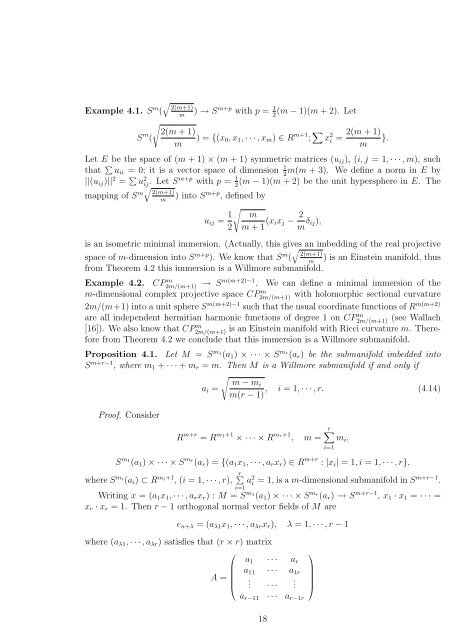The second variational formula for Willmore submanifolds
The second variational formula for Willmore submanifolds
The second variational formula for Willmore submanifolds
You also want an ePaper? Increase the reach of your titles
YUMPU automatically turns print PDFs into web optimized ePapers that Google loves.
Example 4.1. Sm �<br />
2(m+1)<br />
(<br />
S m (<br />
�<br />
m<br />
) → Sm+p with p = 1(m<br />
− 1)(m + 2). Let<br />
2<br />
2(m + 1)<br />
m<br />
) = {(x0, x1, · · · , xm) ∈ R m+1 ; � x 2 i =<br />
2(m + 1)<br />
m<br />
}.<br />
Let E be the space of (m + 1) × (m + 1) symmetric matrices (uij), (i, j = 1, · · · , m), such<br />
that � uii = 0; it is a vector space of dimension 1m(m<br />
+ 3). We define a norm in E by<br />
2<br />
||(uij)|| 2 = � u2 ij. Let Sm+p with p = 1(m<br />
− 1)(m + 2) be the unit hypersphere in E. <strong>The</strong><br />
2<br />
mapping of Sm �<br />
2(m+1)<br />
) into Sm+p , defined by<br />
m<br />
uij = 1<br />
�<br />
m<br />
2 m + 1 (xixj − 2<br />
m δij),<br />
is an isometric minimal immersion. (Actually, this gives an imbedding of the real projective<br />
space of m-dimension into Sm+p ). We know that Sm �<br />
2(m+1)<br />
( ) is an Einstein manifold, thus<br />
m<br />
from <strong>The</strong>orem 4.2 this immersion is a <strong>Willmore</strong> submanifold.<br />
Example 4.2. CP m 2m/(m+1) → Sm(m+2)−1 . We can define a minimal immersion of the<br />
with holomorphic sectional curvature<br />
m-dimensional complex projective space CP m 2m/(m+1)<br />
2m/(m+1) into a unit sphere Sm(m+2)−1 such that the usual coordinate functions of Rm(m+2) are all independent hermitian harmonic functions of degree 1 on CP m 2m/(m+1) (see Wallach<br />
[16]). We also know that CP m 2m/(m+1) is an Einstein manifold with Ricci curvature m. <strong>The</strong>re-<br />
<strong>for</strong>e from <strong>The</strong>orem 4.2 we conclude that this immersion is a <strong>Willmore</strong> submanifold.<br />
Proposition 4.1. Let M = Sm1 (a1) × · · · × Smr (ar) be the submanifold imbedded into<br />
Sm+r−1 , where m1 + · · · + mr = m. <strong>The</strong>n M is a <strong>Willmore</strong> submanifold if and only if<br />
Proof. Consider<br />
ai =<br />
�<br />
m − mi<br />
, i = 1, · · · , r. (4.14)<br />
m(r − 1)<br />
R m+r = R m1+1<br />
r�<br />
mr+1<br />
× · · · × R , m =<br />
i=1<br />
S m1 (a1) × · · · × S mr (ar) = {(a1x1, · · · , arxr) ∈ R m+r : |xi| = 1, i = 1, · · · , r},<br />
where Smi (ai) ⊂ Rmi+1 r�<br />
, (i = 1, · · · , r),<br />
a<br />
i=1<br />
2 i = 1, is a m-dimensional submanifold in Sm+r−1 .<br />
Writing x = (a1x1, · · · , arxr) : M = Sm1 (a1) × · · · × Smr (ar) → Sm+r−1 , x1 · x1 = · · · =<br />
xr · xr = 1. <strong>The</strong>n r − 1 orthogonal normal vector fields of M are<br />
mi,<br />
en+λ = (aλ1x1, · · · , aλrxr), λ = 1, · · · , r − 1<br />
where (aλ1, · · · , aλr) satisfies that (r × r) matrix<br />
⎛<br />
⎜<br />
A = ⎜<br />
⎝<br />
a1<br />
a11<br />
.<br />
· · ·<br />
· · ·<br />
· · ·<br />
ar<br />
a1r<br />
.<br />
ar−11 · · · ar−1r<br />
18<br />
⎞<br />
⎟<br />
⎠



